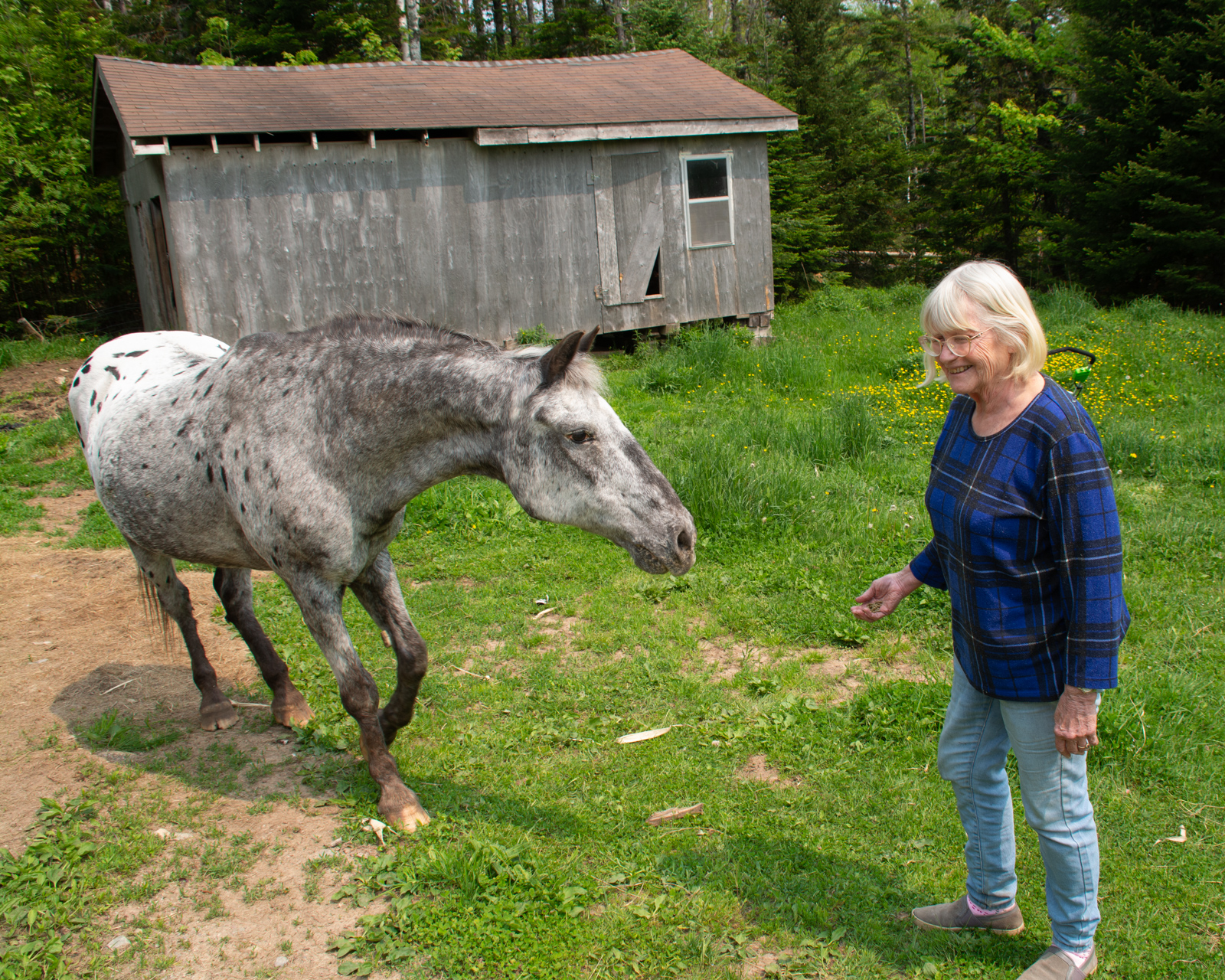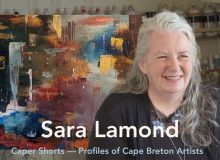Catherine Moir
At 70, after nearly 50 years as an artist, Catherine is feeling an urgency to sell more of her paintings.
On Catherine Moir’s front porch, a sweet young spaniel wagged his tail in greeting. We entered through the front door, but Catherine ushered us right out the back door into her green, woodsy smelling yard. It had the feel of a zen garden, only Canadian — more wild and unruly. There was a little meandering brook, a footbridge and a swimming hole overlooked by willows named after her parents.
An easel was positioned in the grass near the trees where she and her students paint en plein air. The woods were early summer lush when we visited and the blackflies were out. Up the hill towards the road was her newly sprouting vegetable garden and the other way towards the woods she said you could walk way back beyond her three acres and never see a soul. Nature offers peace, inspiration and a buffer, and Catherine keeps it close.
We also met her other animal companion, an old but frisky 37-year-old horse, Manny the Appaloosa. She’s had him since he was a colt and they are old friends. He nickers and nuzzles her. “We’ve been together for so long, I don’t know what I’ll do when he finally disappears,” she said.
Back inside her living room/gallery, new and older paintings cover the walls and are stacked in the corners. Meadow, the spaniel, hides under the living room furniture and pops out periodically for pats.
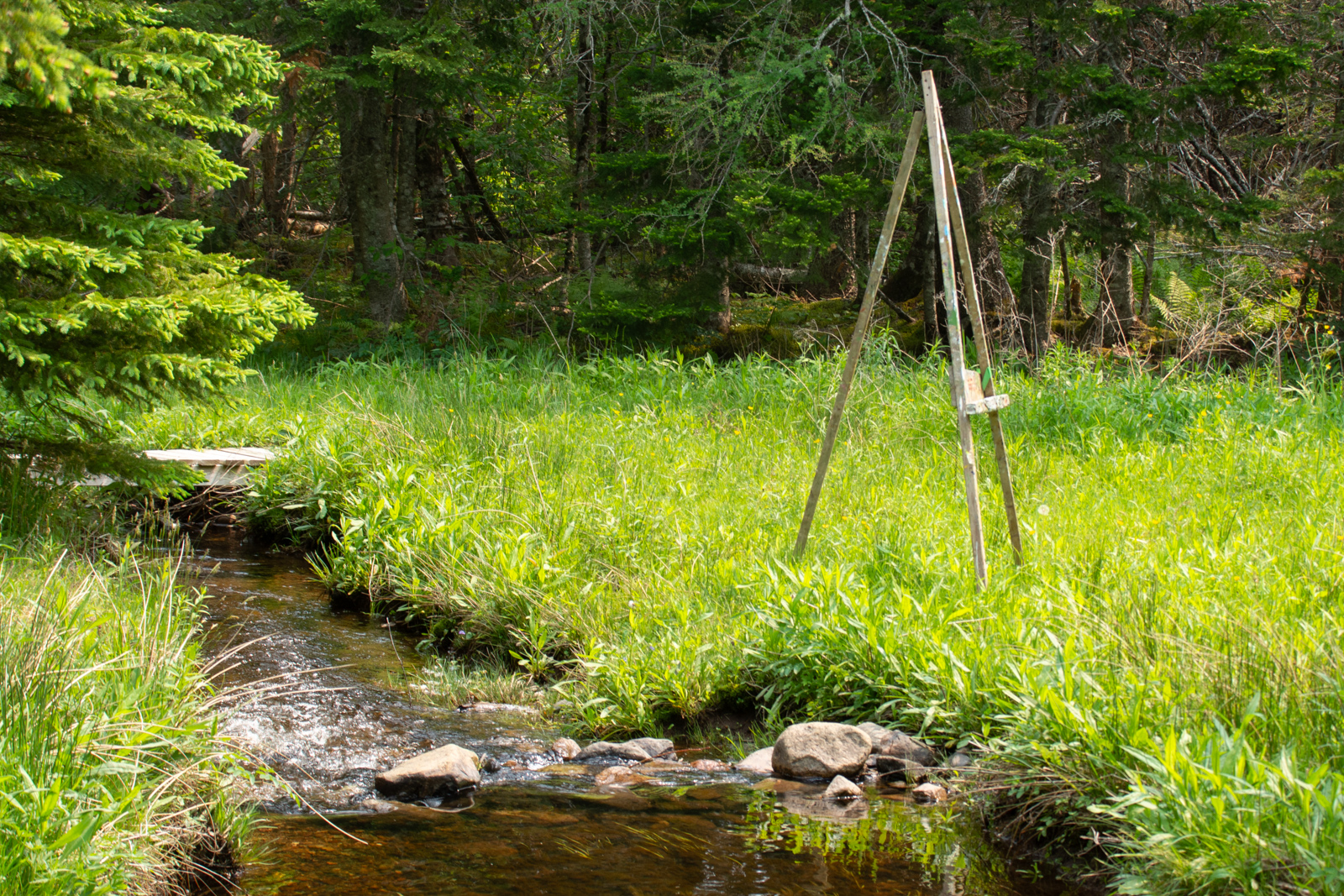
A time to sell
There is no doubt that Catherine Moir, a painter for nearly 50 years, is an artist of talent. Her deep feeling and appreciation for Cape Breton landscapes and, quite frankly, her deep feeling for everything, comes through her brushstrokes. She works in oils and acrylics and sometimes watercolour, but like many artists she struggles with the business end of things — getting the word out and selling her work. Although Cape Breton provides the visual beauty that is the bedrock of her work, living here poses some hurdles like getting exposure and the right audience to buy it. “It would be nice to get my paintings out where people haven’t heard of me before,” she mused.
“This is my big push… I need to do something with this stuff and I feel very inspired to get it sold,” she said, launching into a discussion about marketing and selling artwork. What’s the best tactic: online stores? galleries? social media? pop ups? She simply wants her paintings sold. She has been successful making sales in the past, but sales haven’t kept up with the volume of her work. Then there was the COVID pandemic factor that limited face-to-face contact for selling. Inevitable endings seem to be on her mind lately and her candor was both startling and refreshing. “I would like to sell these paintings now so I will feel more at ease to keep creating. Hopefully it won’t be soon, but when I do die, I don’t want to leave a lot of art for my kids to stack up in their houses.”
A time to paint
Catherine began her studies as an artist at the Nova Scotia College of Art and Design (NSCAD) at 18, but soon moved on and found herself a mentor in painter, Alan Wylie. He was educated at the Royal Academy of Art in London, England, but later made Nova Scotia his home. She studied with him for a year at Ten Mile House in Halifax and “learned a lot of his tricks.” She gave an example: “Hills that are far away look more blue and even purple. Our eyes don’t record yellow after a certain distance. So, yellow is used in the foreground to bring it out.”
She went pro in 1973, painting plein air landscapes, still life and figures, plein air being her first love. “I love painting right there. I find that whatever it is that I feel will make a great painting starts coming alive in my mind. It can be a landscape or it can just be a shadow on the side of a tree.”
If pressed to describe her style she says impressionistic and Canadian. “Impressionism gives you the feeling of a moment in time. I like that idea and I try to do that,” she said. And for her “Impressionism has a lot of feeling.”
Catherine moved to Cape Breton in 1984 and has painted its landscapes ever since. And she has a process. She says, “I go out and I find a place I want to paint that visually speaks to me immediately. It’s not a mental process, it’s a visual process.
“Then, before I go back out, I figure out the palette so when I do go back out I have my palette and I cover the canvas within about two hours. That captures the feeling. That’s Impressionism. A moment in time.
“And then I go back to my studio. It’s while I’m in the studio that I make all the changes, and it could take months. I just work on it as long as I want, taking things out, putting things in, it doesn’t matter.”
Paintings go public
Her paintings have been shown in solo and group shows at Cape Breton University, St. Francis Xavier University and through Visual Arts Nova Scotia. Several Nova Scotian galleries, including the Art Bank of Nova Scotia, have her paintings on display and some have been purchased for private collections internationally.
In 2012 she was hired by the Nova Scotia government to create four 30 x 40 inch landscape paintings to be on permanent display at Open Hearth Park in Sydney, NS. The park transformed the toxic Sydney Tar Ponds into a beautiful space along the waterfront.
Organizers took Catherine on a tour of the site and described what they were trying to do. “They told me what they wanted,” she said. “They wanted to show what they could do with this area.”
The Open Hearth Project

Our pick of some of her paintings
But this is now. “There are way too many paintings in my house,” she said as she went around the room and described them one by one. There are stories that go with them all. Here are a few.
Train Bridge in Wentworth Park
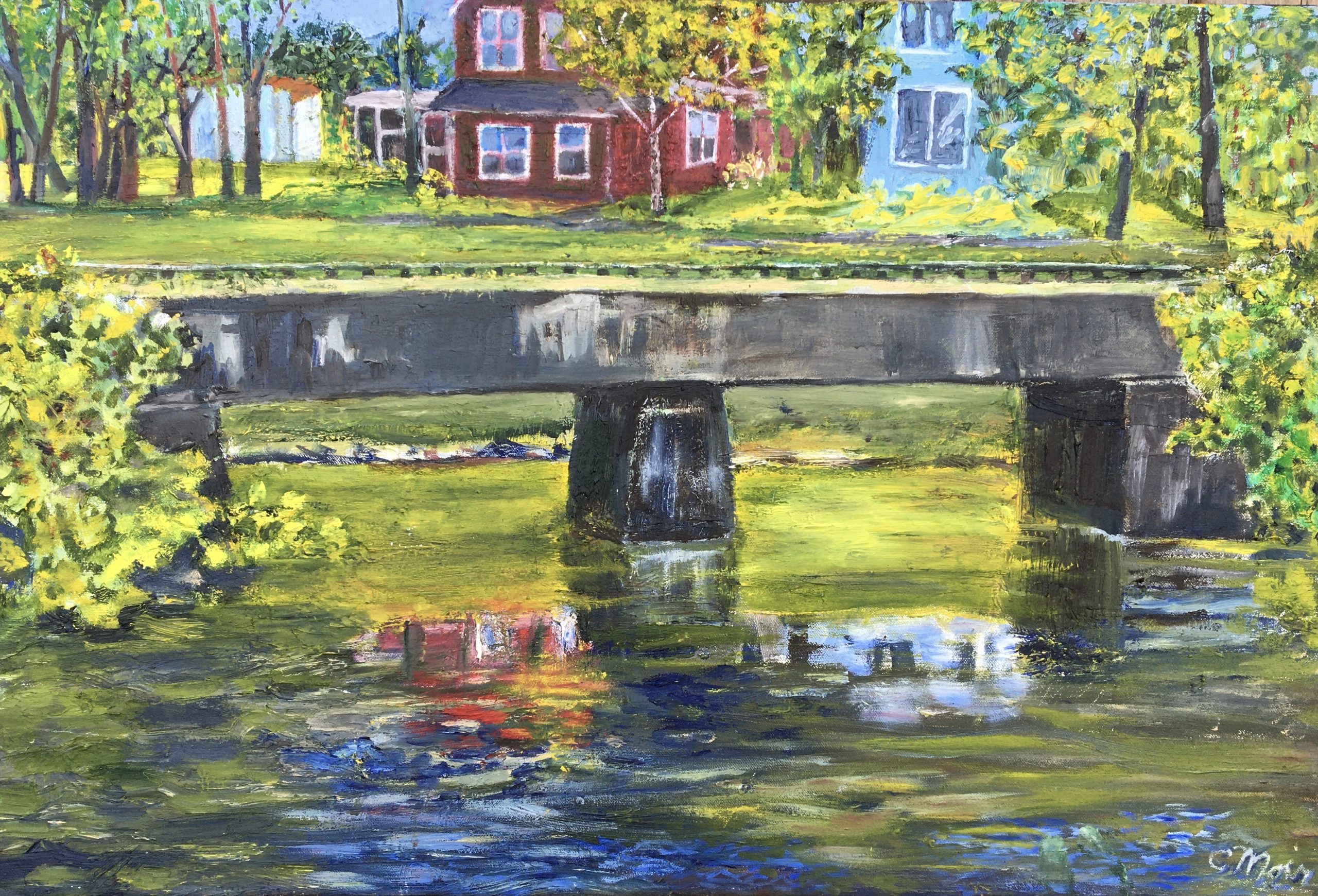
It’s a painting of a train bridge in Wentworth Park in Sydney, NS, and it was the reflection in the water that fascinated her and that she had to get just right. “The reflection was amazing… the reflection of houses in the water were brighter than the actual house.” She captured that the first time and never changed it. But it took more than a year before she was satisfied with most of the rest of it, especially that train bridge. “I had to paint over and over it to get the bridge to come out.” In the end, she got it with a little trick, but she thinks she’ll keep that a secret.
Like Looking Through a Curtain of Unmarked Graves
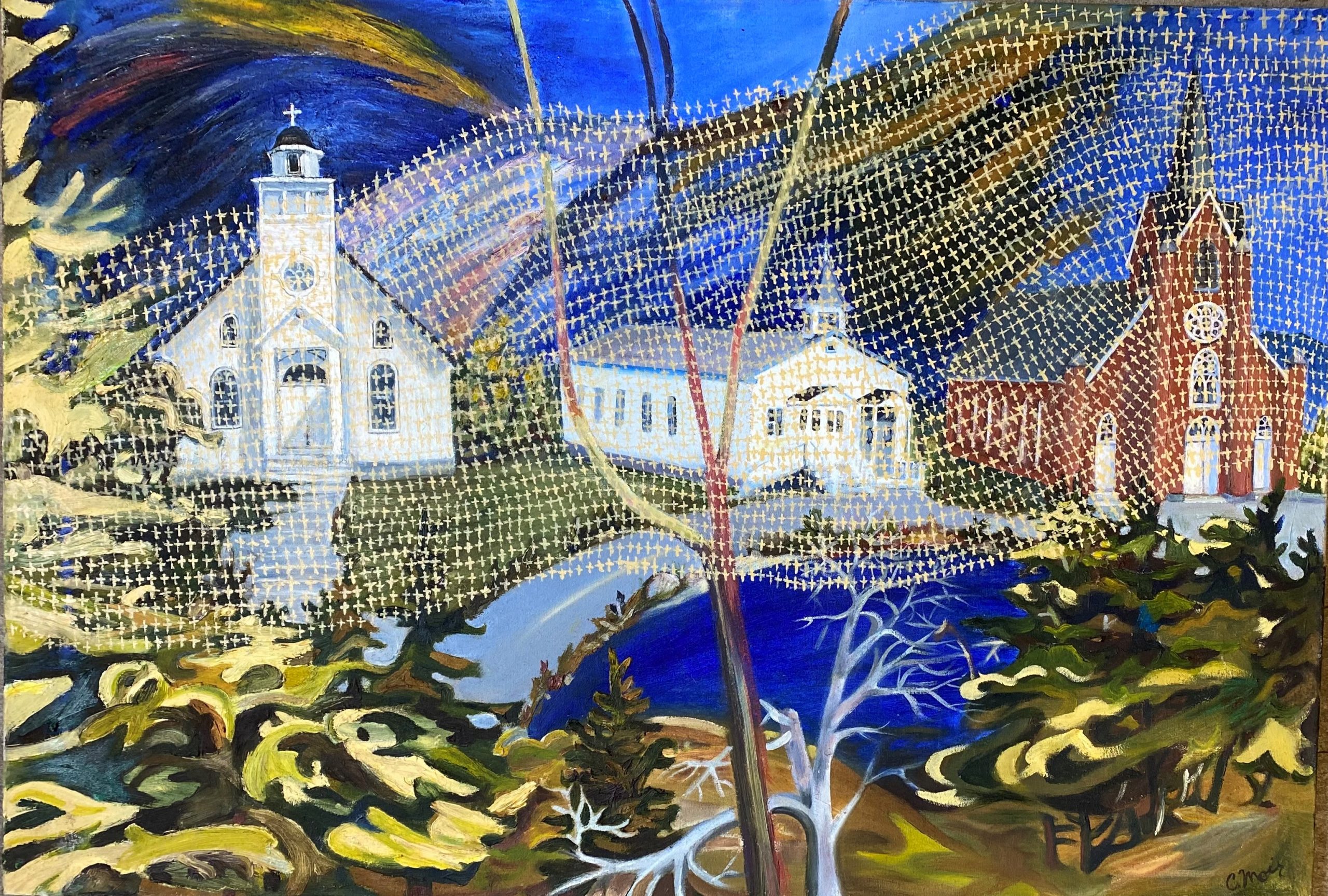
“I am a Catholic Buddhist,” she said, by way of prefacing the next painting. “I started a painting of three churches where I attended mass in the past,” she said. “I was going to gift it to St Mary’s Church in East Bay.” Then the news broke of the unmarked graves at the Catholic residential schools and the sheer numbers were shocking. She painted 3,200 crosses over the painting so that if you want to see the churches, you have to look through a curtain of crosses.
“If you’re looking at the painting, you’re looking at unmarked graves.”
As for the Buddhist influence, Catherine finds that meditation is a help when it comes to painting. “I’ve been sitting regularly for over thirty years now and am part of a small meditation group here in Cape Breton.” She’s been to Gampo Abbey in Pleasant Bay, NS, several times over the years, has done many solitary and group retreats, and once did a three month guided solitary retreat in Iona. During this time she was allowed periods for painting and studied “Dharma Art” by Chogyam Trungpa Rinpoche. “That’s when I realized how often I felt aggression while painting — in other words, wanting something to be a certain way. I learned to drop that aggression. My painting hasn’t changed that much but it’s a lot more fun.” That insight came a good 20 years ago.
Take Off
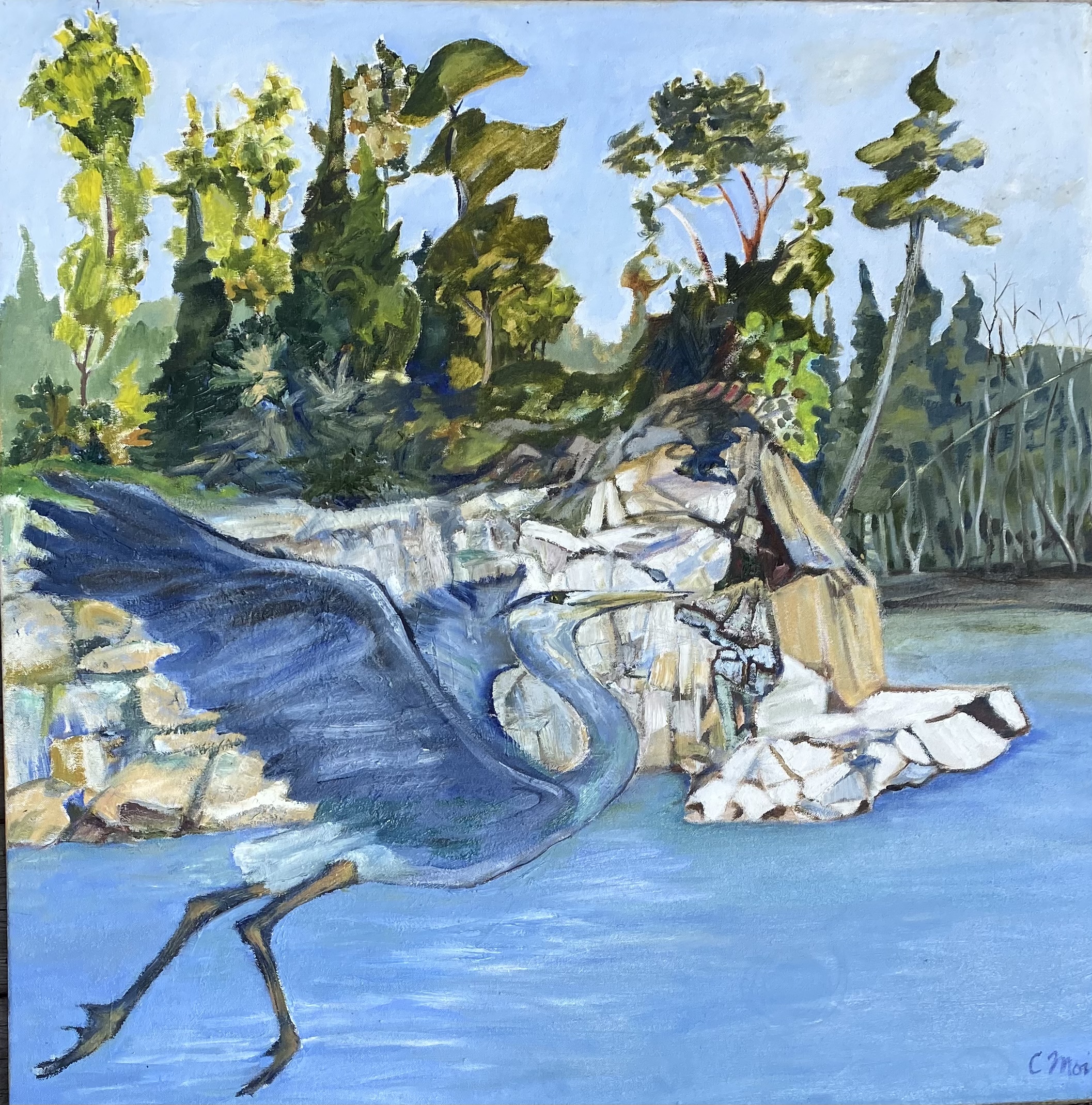
A painting of a great blue heron started out as a view of St Ann’s Bay with her now ex-husband in the foreground fishing in a boat. But she later took him out of the scene. “I go back and change things,” she said. She asked herself, “What do I want?” She likes the way herons kind of run on the water when they take off, so the painting is named Take Off, pun intended.
Sensorium
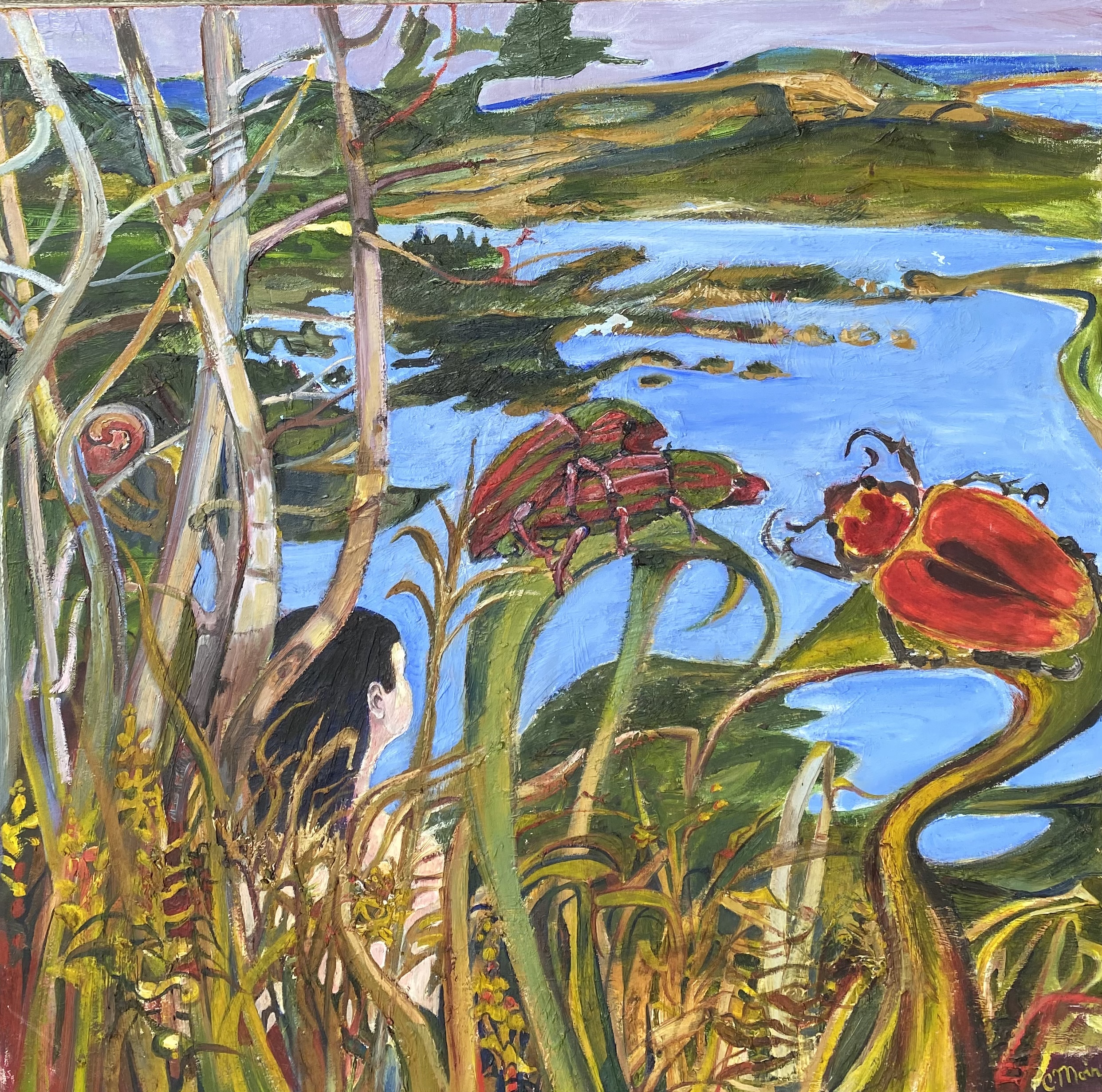
From a corner of the room she pulled out a painting with a closeup of two mating striped beetles and a large red scarab beetle in a lush forest next to a river. It eventually was exhibited in a show called Sensorium or sensory delight. She started the landscape looking down at the mouth of the Baddeck River, but was having a bad day, threw red paint on the canvas and left the half-finished painting in the woods.
She later retrieved the canvas. Coincidentally, a short time later, a photo of a luminous red scarab beetle on the cover of National Geographic caught her attention. It was the same colour as her angry red splashes. She reworked her canvas and morphed the paint spatter into a jewel-like beetle. In the article itself there was a photo of two mating beetles which she added and set in the sensual scene along with a beautiful woman gazing on the mouth of the river.
Solitude
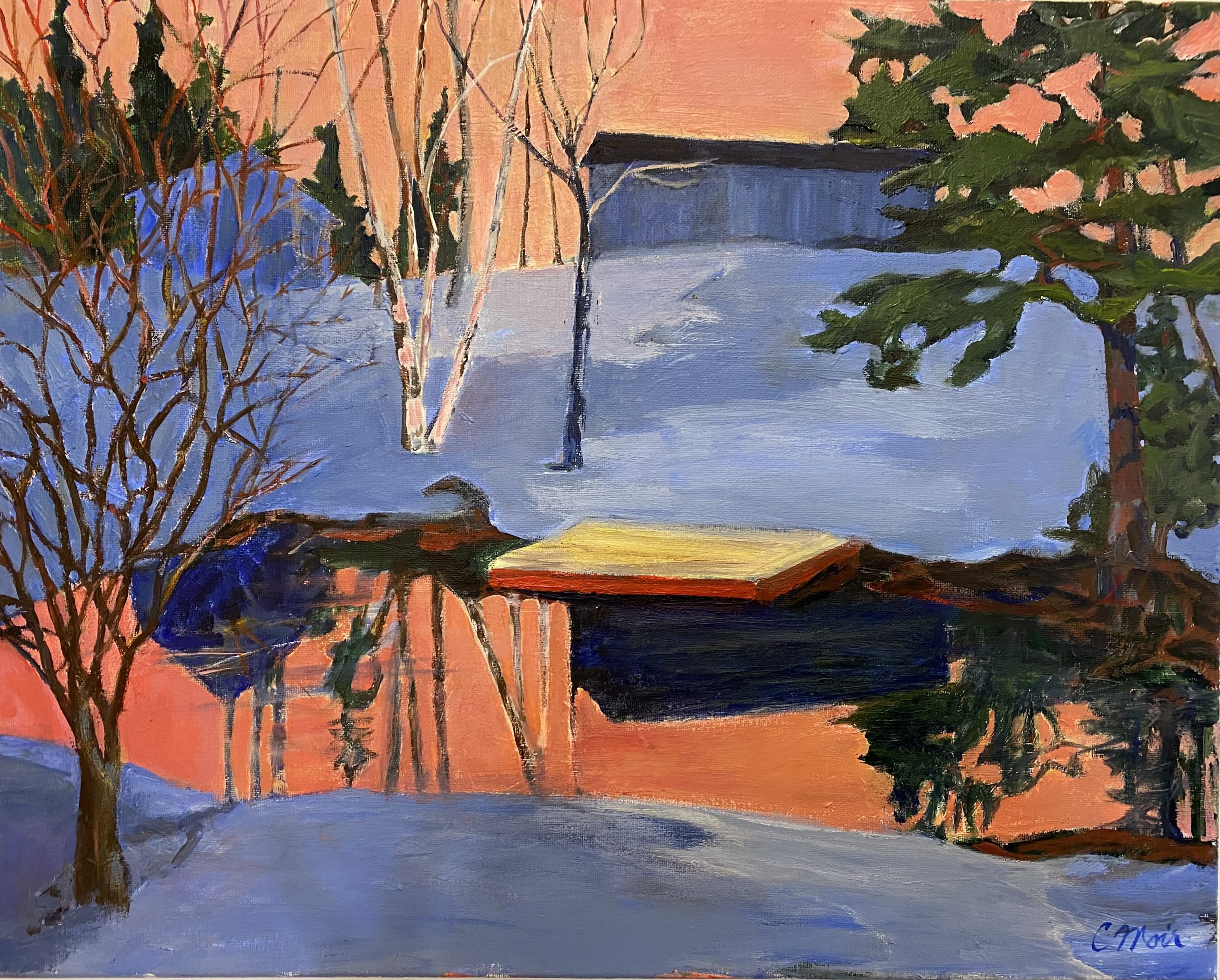
At the beginning of the COVID pandemic she painted Solitude. She was living a solitary life and it was deeply lonely. It was late afternoon. “I was down there in the snow. Not a single footprint in the snow. Silence everywhere.” The painting looks upward toward her house and studio. Above the deep blue snow shadows is a salmon coloured sky, the colour that you see when you look at a bright light through closed eyelids, which is reflected in the pool below. It’s cold, but sky and reflection give a promise of warmth. The observer is outside, yet inside something else, where objects have an internal light. She captured that light with the silhouetted trees as witnesses.
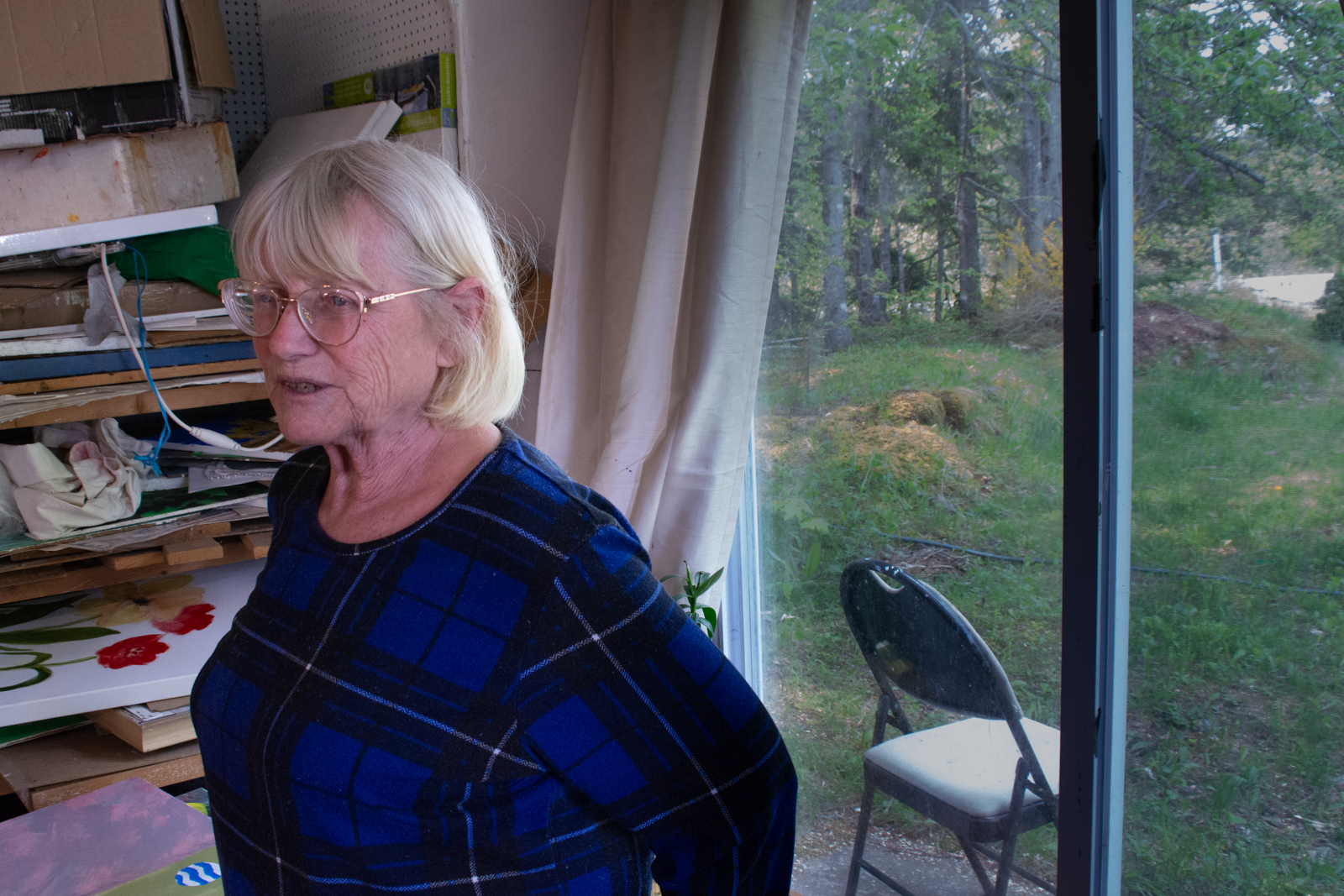
The Art of Living Project
Being a mature painter allows bringing all that you have experienced and accomplished to your creativity. There is a richness in that. It also allows you to give back. Eleven years ago Catherine joined the Art of Living Program which pairs up artists with cancer patients to help them express what they’re going through and she is now the coordinator. Then five years ago she herself was diagnosed with cancer but it’s behind her now. She said, “I don’t want my cancer to be part of my story.” But she gained “a huge insight into how cancer patients felt from how I felt.”
The Art of Living is still very much part of her life and involves “talking, being compassionate, a lot of listening.” The artwork grows out of the dialogue. She said, “As the mentor artist, my job is to listen deeply and assist without judgment so the participants are the true artists in this program. To be with someone at the palliative stage of their cancer and to be creative with them is a true honour and insight for an artist. Surprisingly, much of what is expressed is positive, even when it is dealing with past or present suffering.” She said the uplifting nature of the creative act has its way.
(The co-created paintings from the Art of Living program are eventually exhibited at the Cape Breton Centre for Craft and Design in Sydney in the third floor Loft gallery. At the time of this writing (July 2023) you can see them through the end of the month. )
Maturity brings insight and change
Changing gears and unfinished business are realities of any working artist’s life.
Right now, she does want to sell all those paintings in her house but she doesn’t want to let it stifle her creativity. Buddhism has helped her put the problem into perspective. After one particular silent retreat, when talking was allowed again, Catherine complained to her friend that she felt like holding back instead of going ahead with another large painting.
“How do you feel when you paint?” her friend asked.
“I feel great. I feel like myself. I don’t need anything else.”
And her friend replied, “So, that’s the answer, go ahead and paint. After all, it’s only canvas.”
That was great advice.
After seeing her work for myself, I say yes, that is the answer. Please do. Go ahead. Paint.
Interested in buying?
If you want to buy paintings from this woman, here’s how:
Visit her at her home gallery at 523 Morley Rd.,
Sydney Forks, N.S. B1L 1E2 902-577-9645
Instagram: artistcatherinemoir
Web site: catherinemoirart
Facebook: Catherine Moir Artist
A painting entitled Looking Through the Trees Can be viewed at the Cape Breton Centre for Craft and Design at 322 Charlotte St. Sydney, N.S.
https://capebretoncraft.com/artisans/catherinemoir/
— She also does trades and barter.
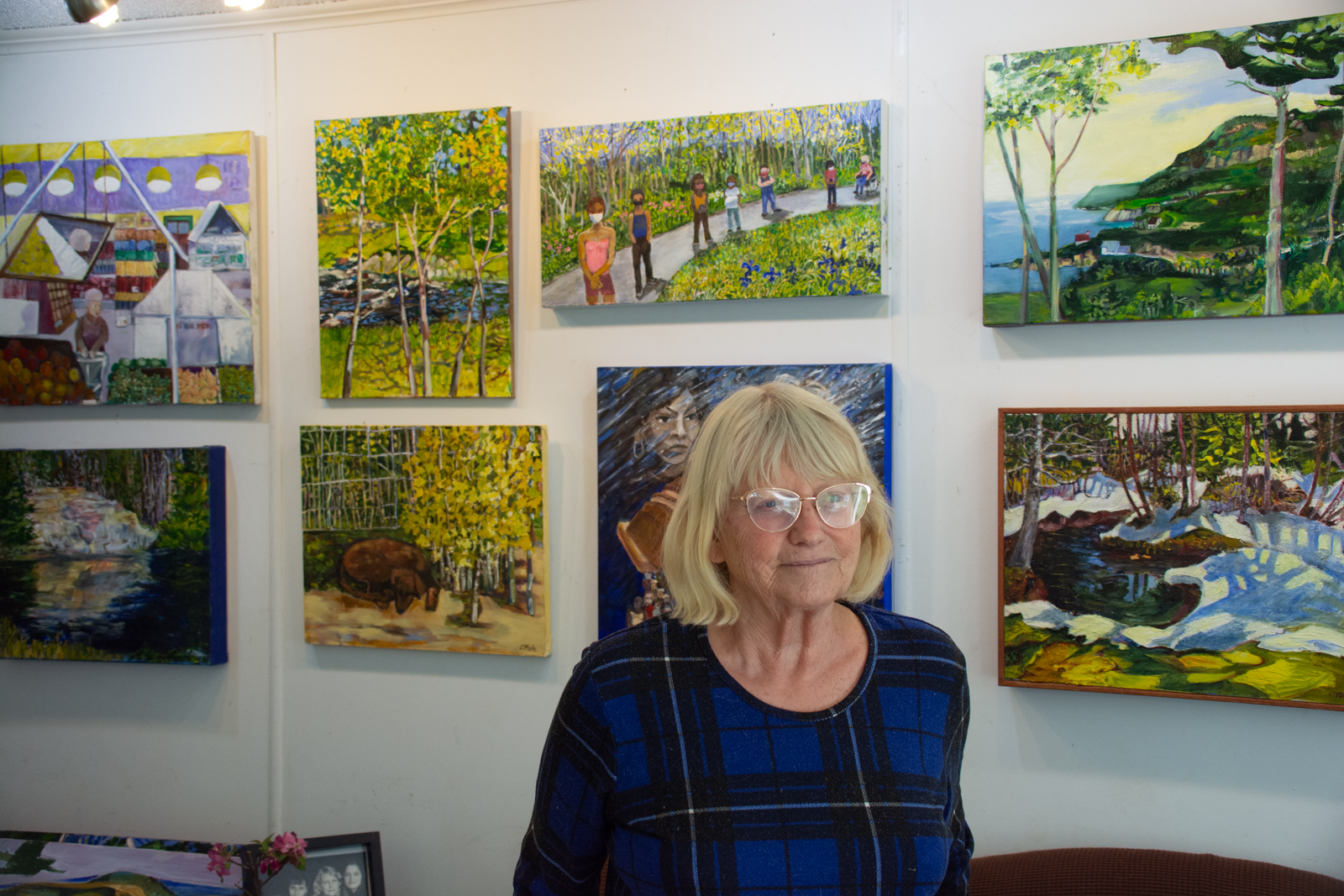
Manny
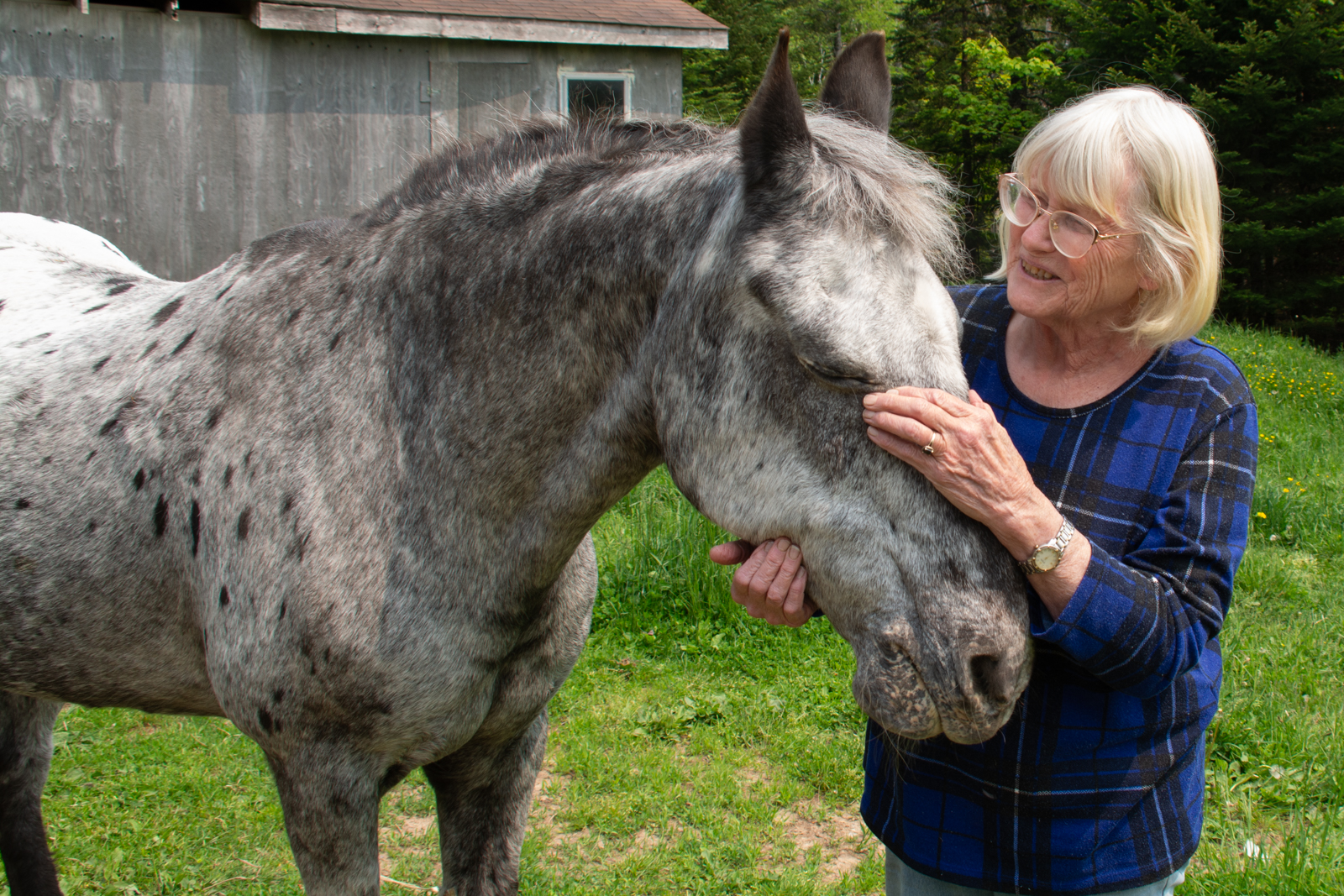
Meadow
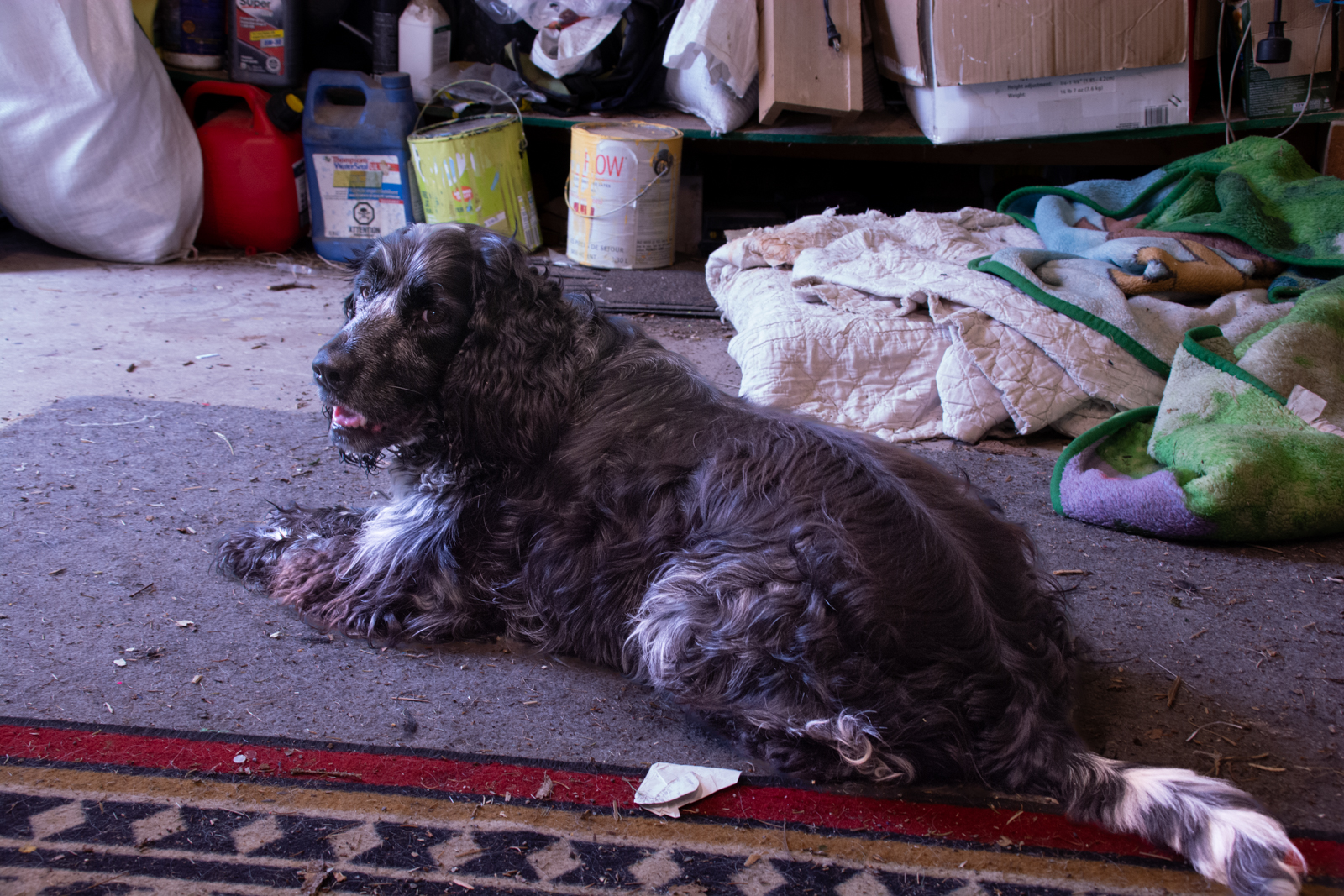
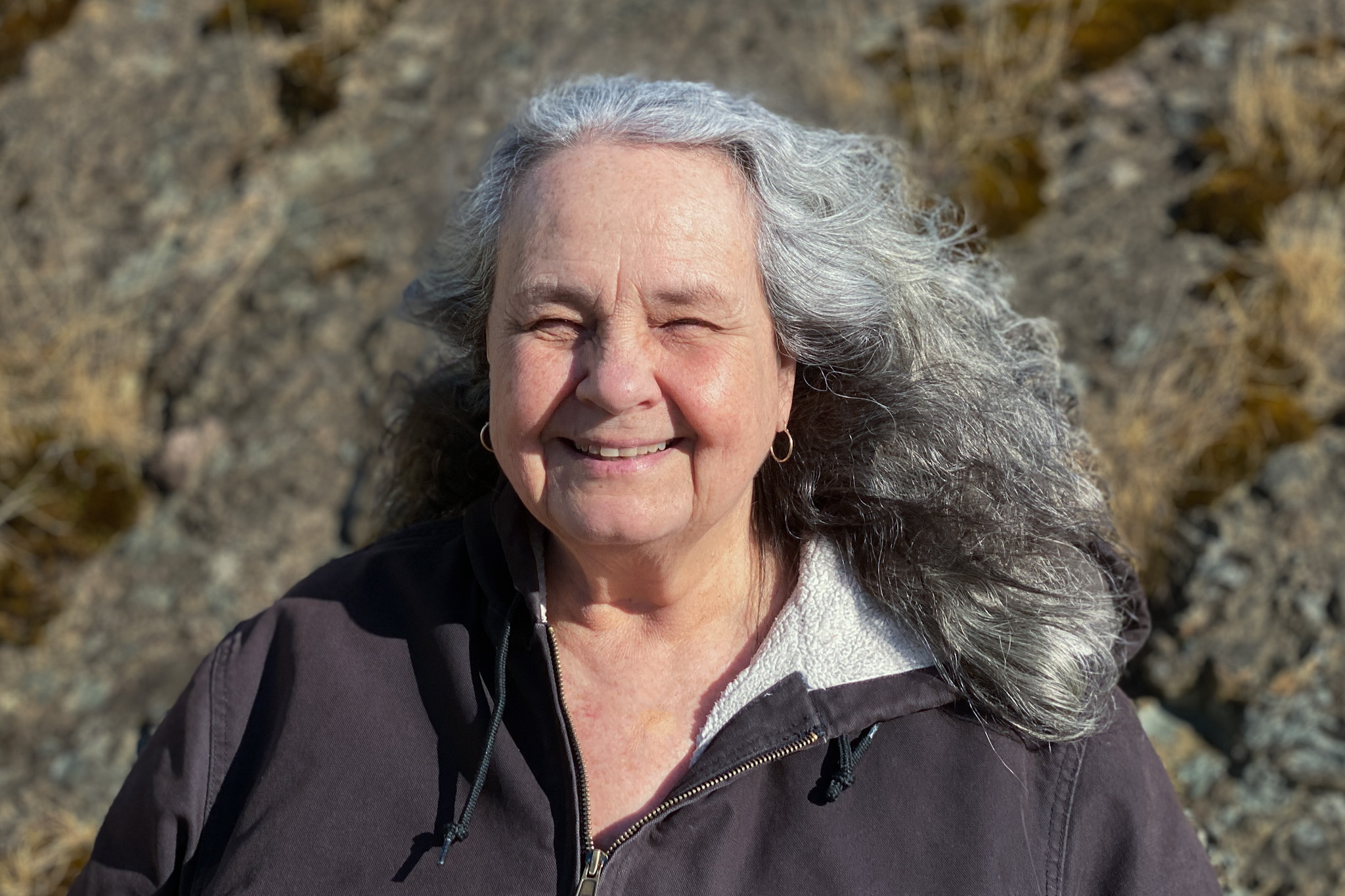
Author details
Elaine Mandrona, in addition to being a writer, is a painter and sculptor. She moved to Cape Breton permanently in 2021.
